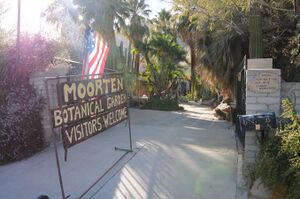Biology:Moorten Botanical Garden and Cactarium
| Moorten Botanical Garden | |
|---|---|
 The entrance to the Moorten Botanical Garden | |
| Type | Botanical |
| Location | Palm Springs, California, US 1701 South Palm Canyon Drive |
| Coordinates | [ ⚑ ] : 33°48′01″N 116°32′46″W / 33.8003°N 116.5460°W |
| Area | 1 acre (0.40 hectares) |
| Opened | 1938 |
| Visitors | 200 per day |
| Plants | Cacti |
| Species | 3,000 |
| Collections | Desert climates |
| Website | www |
The Moorten Botanical Garden and Cactarium is a 1 acre (0.40 ha) family-owned botanical garden in Palm Springs, California, specializing in cacti and other desert plants. The gardens lie within Riverside County's Coachella Valley, part of the Colorado Desert ecosystem.
History
The Moorten Gardens were established as a nursery in 1939 by Patricia and Chester "Cactus Slim" Moorten,[1] and developed into the present day garden in 1955.[2] Chester, one of the original Keystone Cops, starred in Two Flaming Youths (1927) and The Sideshow (1928).[2][3] The Moorten residence was named the Cactus Castle, and was originally built in Mediterranean style by photographer Stephen H. Willard (1894–1966).[4] The Moortens collected many of their own specimen plants from Baja California, mainland Mexico, and as far south as Guatemala. To recognize their contributions to the community, the Moortens were awarded "Golden Palm Stars" on the Palm Springs Walk of Stars.[5]
Collections
Ecoregion habitats
The garden includes 3,000 examples of desert cacti and other desert plants,[6] grouped by geographic regions:
- Arizona – Sonoran and Yuma Deserts
- Baja California Peninsula
- California – High Desert–Mojave Desert and Low Desert–Colorado and Yuha Deserts
- Colorado Plateau – Great Basin Desert
- Sonora, Mexico – Gran Desierto de Altar
- South Africa – Succulent Karoo
- South America – Monte and Patagonian Deserts
- Texas – Chihuahuan Desert
Garden collections
Outdoor collections include: Agaves, Bombax, crested Cereus, Cardoon and Boojum trees, "arborescent candelabra Euphorbia", a two-story Pachypodium, thorned Caesalpinia and Bursera, and over a dozen Aloes of southern Africa and Madagascar .
"Cactarium" greenhouse collections include: cacti and succulents, with caudiciform species exhibiting thickened root crowns, many species of Asclepiads, Aztecia, Gymnocalycium, Alstromeria, Euphorbia, and Ferocactus, plus two fine examples of Welwitschia mirabilis from Namibian deserts.
See also
- Living Desert Zoo and Gardens
- List of botanical gardens in the United States
References
- ↑ Mitchell, Gordon "Whitey" (2006). Star Walk: A Guide to the Palm Springs Walk of Stars. Palm Springs, California: Hall/Sloane. p. 99. ISBN 978-0-9638683-4-3.
- ↑ 2.0 2.1 Meeks, Eric G. (2014). The Best Guide Ever to Palm Springs Celebrity Homes. Horatio Limburger Oglethorpe. p. 294. ISBN 978-1479328598.
- ↑ IMDb entry on Chester Morten
- ↑ Giles, Christine (2007). "23: The Ansel Adams of the Desert: Stephen H. Willard". in Peter Wild. The Grumbling Gods: a Palm Springs Reader. Salt Lake City, UT: University of Utah Press. ISBN 978-0-87480-899-5. OCLC 122974473, 608203796, 608020250 (print and on-line)
- ↑ Palm Springs Walk of Stars: By Date Dedicated
- ↑ McClure, Rosemary (2020-02-27). "Seeing these beautiful Southern California gardens won't break your budget" (in en-US). Los Angeles Times. https://www.latimes.com/travel/story/2020-02-27/southern-california-cheap-gardens-travel.
Further reading
- Moorten, Patricia (1969). Desert Plants for Desert Gardens. Palm Desert, CA: Best West Pubs.. pp. 112. LCC QK938 D4 M6
- Niemann, Greg (2006). "45: Still Going After All Those Years – Legendary Places in Palm Springs". Palm Springs Legends: creation of a desert oasis. San Diego, CA: Sunbelt Publications. pp. 286. ISBN 978-0-932653-74-1. OCLC 61211290. (here for Table of Contents)
External links
- Howser, Huell (October 28, 1999). "Palm Springs History Tour #1 – Visiting (715)". California's Gold. Chapman University Huell Howser Archive. http://blogs.chapman.edu/huell-howser-archives/1999/10/28/palms-springs-history-tour-1-visiting-715/. – With commentary by Frank Bogert; starts at the McCallum Adobe Museum and ends at the botanical garden.
 |


